How Hospital Administrators Can Ensure Their Surgeons Have the Latest Equipment
Hospital administrators play a pivotal role in maintaining high standards of care, and one of the most effective ways to ensure surgeons have access to the latest equipment is through regular technology audits. These audits assess the current inventory, identify outdated tools, and highlight areas where upgrades are needed. By systematically reviewing surgical instruments, imaging systems, and monitoring devices, administrators can make informed decisions about procurement and replacement.
Collaborating with Clinical Teams
Open communication between administrators and surgical teams is essential. Surgeons are best positioned to identify the tools they need to perform at their highest level. Administrators should establish feedback channels—such as equipment request forms, regular meetings, and cross-functional committees—to gather insights directly from the operating room.
This collaboration ensures that investments are driven by clinical necessity rather than administrative assumptions. When surgeons feel heard and supported, they are more likely to embrace new technologies and integrate them effectively into their practice.
Staying Informed on Medical Innovations
To keep pace with rapid advancements, hospital administrators must stay informed about emerging technologies and industry trends. Attending medical conferences, subscribing to clinical journals, and networking with vendors are all valuable strategies. These efforts provide exposure to cutting-edge tools and allow administrators to evaluate their potential impact on patient care. Administrators can also benchmark against peer institutions to understand what technologies are being adopted elsewhere. This comparative insight helps prioritize upgrades that enhance competitiveness and improve surgical outcomes.
Strategic Budgeting and Investment Planning
Acquiring the latest medical equipment requires thoughtful financial planning. Administrators should develop strategic budgets that allocate funds for technology upgrades, factoring in both immediate needs and long-term goals. This includes exploring leasing options, vendor discounts, and government grants that can offset costs.
Investing in high-impact equipment—such as robotic surgical systems, advanced imaging platforms, and AI-powered diagnostic tools—can yield significant returns in terms of patient safety, operational efficiency, and reputation. Administrators must balance cost with value, ensuring that each purchase contributes meaningfully to clinical excellence.
Partnering with Trusted Suppliers
Building strong relationships with reputable medical suppliers is key to accessing the latest innovations. Trusted vendors often provide early access to new products, training support, and maintenance services that extend the life of equipment. One such partner is Baxter Advanced Surgery, known for delivering high-quality surgical solutions that enhance precision and safety. By partnering with companies like Baxter, administrators can ensure their surgeons have access to cutting-edge tools such as hemostatic agents and tissue sealing technologies. These products not only improve surgical outcomes but also demonstrate a commitment to excellence in patient care.
Conclusion
Ensuring surgeons have the latest equipment is a multifaceted responsibility that requires vigilance, collaboration, and strategic foresight. By conducting regular audits, engaging with clinical teams, staying informed, budgeting wisely, and partnering with trusted suppliers, hospital administrators can create an environment where innovation thrives. In doing so, they empower their surgical teams to deliver the highest standard of care and position their institutions at the forefront of modern medicine.





